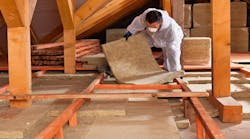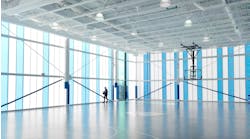When it comes to building insulation, the options can be overwhelming, particularly for owners who want to decrease their carbon footprint, increase their R-value, qualify for environmentally based certifications or are concerned about asbestos.
Luckily, the vast number of insulation types means that there are plenty of alternatives out there, from natural materials to recycled options.
Cellulose Fiber
Cellulose makes up the cell walls and fibers in plants, including cotton and the 30 percent of a tree that can be made into paper. Cellulose fiber insulation is also the oldest form of insulation, and can be added to enclosed walls and unfinished attic floors as loose-fill, dense-packed or wet spray.
Help BUILDINGS Shape 2019!
What BUILDINGS resources are most valuable to you? What would you like to see us provide?
Please take our short (under 2 minutes) survey - just 5 short questions.
Thank you!
Usually made of recycled newsprint—about 75 to 85 percent recycled content—cellulose insulation is often heavily treated with flame retardants such as boric acid, borax or ammonium sulfate. These chemicals are effective flame retardants and can help reduce pests without harmful side effects to humans.
Inexpensive and containing the highest amount of recycled material of any commercial insulation, the cons of cellulose fiber include the fact that it settles up to 20 percent, which can cause gaps, must be kept dry and is heavier than fiberglass. However, for a majority of building projects, these conditions aren’t problematic.
Free of formaldehyde, asbestos, glass fibers and mineral wool, cellulose fiber insulation diverts hundreds of tons of paper from landfills each year. It also works as an effective noise-dampener, decreasing the amount of sound transmission between walls.
[Related: 6 Myths of Workplace Acoustics Debunked]
Rigid Cork
Unlike malleable insulation types, cork is a semi-rigid material usually made of 100 percent cork. Made of the outer bark of oak trees that have reached a minimum age of 18 years, cork is a completely natural and renewable resource, as removing the bark doesn’t harm the tree and regenerates over time. Harvesting can occur every nine years throughout the tree’s approximately 200-year lifespan.
Using the same geothermal properties as double-glazed windows, the air which fills the space between the cork’s cells makes it an excellent insulator — typically an R-value of 3-4 per inch depending on thickness.
Denim
A form of cellulose fiber (cotton), denim insulation contains the same advantages of recycled paper. Made of the scraps and clippings from denim manufacturing facilities, recycled denim insulation can be used in place of fiberglass or mineral wool batts between open roof rafters, ceiling joists and wall studs.
This eco-friendly insulation has higher-than-average — about 30 percent — acoustic ratings, decreasing sound transmission and increasing sound absorption qualities, while also providing a high rate of thermal performance, between R-13 and R-30.
It is often treated with borate to provide Class A fire resistance, and EPA-registered fungal inhibitors for protection against mold, mildew and pests.
What’s more: the natural cotton fibers used are 100 percent recyclable, closing the lifecycle loop.
Fiberglass
Fiberglass is well-known in the building industry for its durability and light-weight properties. Made up of thin fibers of glass, it traps pockets of air, keeping spaces thermally regulated and insulating against sound transmission between floors or walls. According to some estimates, fiberglass can reduce energy costs by up to 40 percent.
[Read also: How School District Cut 62 Percent in Energy Spending]
Fire resistant, low-weight and malleable, the spongy material has been used for decades by the building industry as insulation.
However, because the material is made up of very fine slivers of glass, the International Association for Certified Home Inspectors warns against several hazards of using fiberglass insulation, including:
- Particles coming into contact with the skin where they can become lodged in pores, causing itchiness, rashes and irritation.
- Airborne particles becoming inhaled, causing coughing, nosebleeds and - in worse case scenarios - lodged in the lungs which is believed to cause health risks.
The ease in which fibers can become loosened from the batting is high, so any disturbance can cause particles to become airborne. It’s suggested that the insulation be dampened before attempting to remove old batting.
With proper equipment, fiberglass can pose a cost-effective and easy solution to insulation issues. In recent years there have been advancements in technology that have allowed even fiberglass insulation to be made in more eco-conscious ways. EcoBatt by Knauf Insulation uses 48 percent recycled glass bottles bonded with a thermosetting resin.
Mineral Wool
Offering superior fire resistance and acoustical performance, mineral wool insulation actually doesn’t contain organic compounds such as wool. Instead, it’s created by spinning or drawing molten mineral, glass, industrial slag and rock until it becomes fibrous materials.
Widely used in Europe and Canada, studies show that it traps air, creating an exceptional thermal properties that decrease the amount of energy used by the building.
Suitable for both wood- and steel-framed buildings, mineral wool is typically made of more than 90 percent mineral fibers and bonded together with binders such as phenolic formaldehyde, which can be problematic to those wishing to decrease their use of formaldehyde and VOCs.
Mycelium
Similar to cork, mycelium insulation is a natural material — fungus — bonded together and providing an R-value of about 3 per inch.
[Related: Fitness Noise and Vibration Considerations in Mixed Use Buildings]
The rigid blocks are made by intertwining the rootlike filaments of a fungus in controlled conditions. The material has only been used for a short time, but new uses are being invented constantly.
Unlike polystyrene insulation, mycelium insulation can withstand heat without additives. Along with the fact that it’s relatively low-cost to create, manufacturers of mycelium, including Ecovative Design, see it fitting into a number of building projects.
The catch? It’s not quite ready to be used as insulation. But it’s promising in the building industry within the next decade.
Wool
Sometimes returning to nature can be better than man-made alternatives. With wool insulation, the natural, renewable resource is not only VOC-free, but the amino acids in the wool can irreversibly bond with formaldehyde and other pollutants to filter air and improve the indoor air quality.
Installed like other malleable materials without the need for protection, wool batts are rated at R-3.6 per inch and loose-fill performs at R-4.3 per inch.
Both batt and blow-in wool insulation provides sound absorption and transmission.
While it doesn’t support mold growth and minimizes condensation, maintaining R-value when wet, wool does absorb and release moisture from ambient air, so the location of the building should be discussed when purchasing wool insulation.
As for end of life: as a natural material, when used without additives, as with products by companies like Havelock Wool, it can be composted.
Two handpicked articles to read next:




